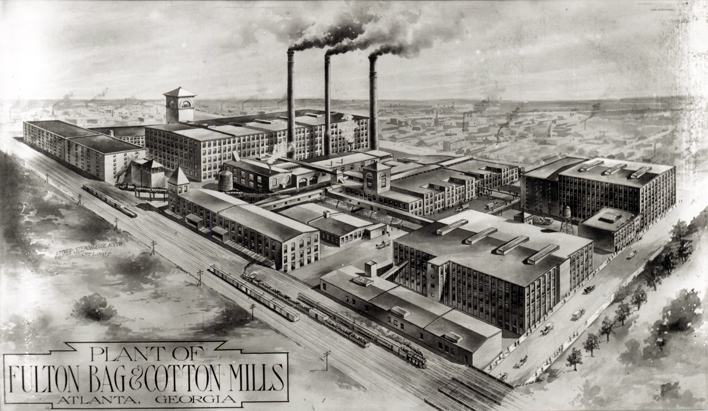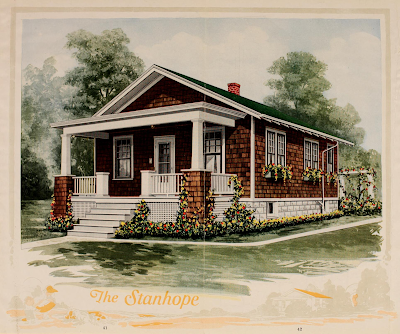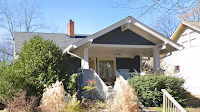The retelling of the kit house story most often revolves around an industrious Do-It-Yourself type building their very own home from plans and materials supplied by a kit house manufacturer. Homes sold to people like this were a big part of the kit house business. Less well known is the fact that the major kit house companies also sold homes to builders, contractors, developers and industrial concerns. Homes purchased by industrial companies to provide worker housing were a part of the kit house business, particularly in the years around "The Great War" (World War I), best exemplified by the 192 Sears "Modern Homes" built in 1918 in Carlinville, Schoper, and Wood River, Illinois by the Standard Oil Company.
 |
| Image of Sears houses in Carlinville, IL from the "Modern Homes" catalog |
The Sears homes built by Standard Oil highlighted a common problem for industrial companies with facilities located in rural areas - too few homes, especially quality homes - in areas seeing surging population growth driven by the construction or expansion of facilities owned by those industrial companies. In communities across the United States, these companies turned to the kit house manufacturers to purchase homes that could be built quickly to provide additional housing for their workers. During those years, the kit house manufacturers often highlighted those purchases in their sales catalogs and newspaper advertising. Aladdin even put together a separate catalog geared towards industrial interests.
In more urbanized settings like Atlanta (population 200,616 in 1920), the challenge was less one of quantity than location. In the years when the nascent auto industry hadn't yet become the preferred mode of transportation, it was common for the majority of a company's workforce to arrive on foot from a nearby neighborhood or by streetcar line. But as you can imagine, private interests weren't exactly clamoring to build quality housing in close proximity to noisy, polluting industrial factories. So these companies often built their own neighborhoods of homes - sometimes company owned or subsidized - near their factories to ensure that their workers were always close at hand.
Back in September 2022, I was reviewing our transcribed list of the Aladdin sales records index (which currently includes 11 years of sales records indexes we photographed a number of years ago) for possible locations of houses. 1919 has quite a few sales to industrial companies. including multiple sales to the "Fulton Bag and Cotton Mills Company" of Atlanta, Georgia. The company purchased 20 homes from Aladdin, mostly models that I was familiar with including the following (number of models in parentheses):
- Boulevard (3)
- Franklin (2)
- Pomona #1 (5)
- Sheridan #2 (3)
- Stanhope #2 (4)
- Sunshine (3)
 |
| Image from 1919 Aladdin Sales Record Index Courtesy of the Clarke Historical Library Aladdin collection |
I'll be honest, I didn't hold out much hope that I would actually find the homes. It's often times hard to track down the location of where these industrial companies - most of which are long out of business - were located. Even if you do, you can imagine what 100 years of time does to homes built in an industrial setting, especially one where the local economy has been depressed as factories have closed down or have been demolished. More than once have I managed to track down the place where a neighborhood of kit houses had been built only to find that those homes had been lost to time.
But my effort to locate the home of the "Fulton Bag and Cotton Mills Company" in Atlanta was aided by a well-documented Wikipedia article that provides the exact location of their mill that operated just east of downtown Atlanta adjacent to the "Cabbagetown" neighborhood. The mill itself has a very interesting history that includes its redevelopment into a residential use. But I was more interested in seeing if there was any signs of Aladdin homes near the factory so I jumped on Google to see what I could learn about "Cabbagetown".
Now that I knew where to look, I started out using Google Streetview to drive up and down the streets of "Cabbagetown" looking for homes from Aladdin. But after a few streets of no Aladdin houses, I decided to switch over to Zillow and search homes "for sale" and "recently sold" in the neighborhood. Since I knew that the homes were built around 1919 - 1920, I limited my search to homes sold between 1900 (a common date used when exact build dates aren't known or have been lost) through 1930, figuring that would cover my bases.
 |
| Aladdin "Stanhope" 116 Estoria Street SE, Atlanta, Georgia |
Now that I had a starting point, I switched back over to Google Streetview and started looking. It didn't take long for me to discover two things - One, Estoria Street was where I wanted to be. In quick succession, I spotted a couple of Aladdin Pomonas, another Stanhope, an Aladdin Boulevard and a distinctive Aladdin Franklin, all models that were on the sales list. Two, these houses all appeared to be in good shape and several sported distinctive details that helped identify that they were Aladdin models.
After my initial discovery, which I shared with my fellow kit house researchers, I got distracted by other shiny baubles of kit house discoveries. But I knew that when I had some free time, which arrived with the holidays, I would go back and do a proper documentation of the homes, which I'm sharing in this post.
Below is a list of the houses by address and Aladdin model. I've included a link to Google Streetview to each house if you want to see a current view of them. At the end, I've also included some addresses of where I think the 4 missing houses were located and my best guess at which model based on reviewing historic aerial photos.
Estoria Street

106 Estoria St SE - Stanhope #2
110 Estoria St SE - Boulevard
114 Estoria St SE - Pomona #1
116 Estoria St SE - Stanhope #2
124 Estoria St SE - Pomona #1
128 Estoria St SE - Stanhope #2
136 Estoria St SE - Franklin
107 Pearl St SE - Franklin
111 Pearl St SE - Sunshine
113 Pearl St SE - Sheridan #2
117 Pearl St SE - Pomona #1
121 Pearl St SE - Boulevard
125 Pearl St SE - Stanhope #2
135 Pearl St SE - Sheridan #2
 |
| 2006 photograph of Pearl Street SE starting with 103 Pearl |
As best as I can tell, the entire order of 20 Aladdin houses was built on the same block - 10 on Estoria Street and 10 on Pearl Street. 16 of the houses are still standing and identifiable as Aladdin models. Of the 4 remaining locations, they are all built on and the houses that have the appearance of being "from the era".
However, after seeing some vacant lots in the area in earlier Google Streetviews, I went back and looked up the build date for those 4 houses in Zillow and found that all of them were built between 2000 and 2016. This was confirmed by a map of the historic district that shows those lots have structures that are "non-contributing", a reference to a building that doesn't date back to the original district era or has been modified to such a degree that it's no longer consistent with the era. So even though these homes look like they could be from the 1920s, they're not.
Based on information from the original 1975 nomination form for the National Register of Historic Places, it appears that all 20 houses were still standing in 1975. By reviewing historic aerial photos, I made an attempt to identify which Aladdin models used to be on those lots based on the rooflines of the previous houses. What's listed below is my best effort to identify those. If I find any photographs from when those houses were still standing which help me confirm the model, I'll update the listing below.
120 Estoria St SE - Build date of 2000 (Likely was Sunshine based on old aerials)
132 Estoria St SE - Build date of 2016 (Likely was Boulevard based on old aerials)
127 Pearl St SE - Build date of 2002 (Likely was Pomona based on old aerials)
133 Pearl St SE - Build date of 2002 (Likely was Sunshine based on old aerials)
Also notable is the house built at 101 Pearl St SE. The house was built in 2007 but echos the details of the Aladdin Pomona next door right down to the Pomona-style brackets!
Discovering houses is always fun and doubly so when you find they are located in an area where people appreciate the history of their homes. I hope this adds to the collective history of "Cabbagetown" and that the owners come to appreciate knowing that they own a unique slice of American history. Thank you for joining me on this journey. I hope to share many more in 2023!











No comments:
Post a Comment